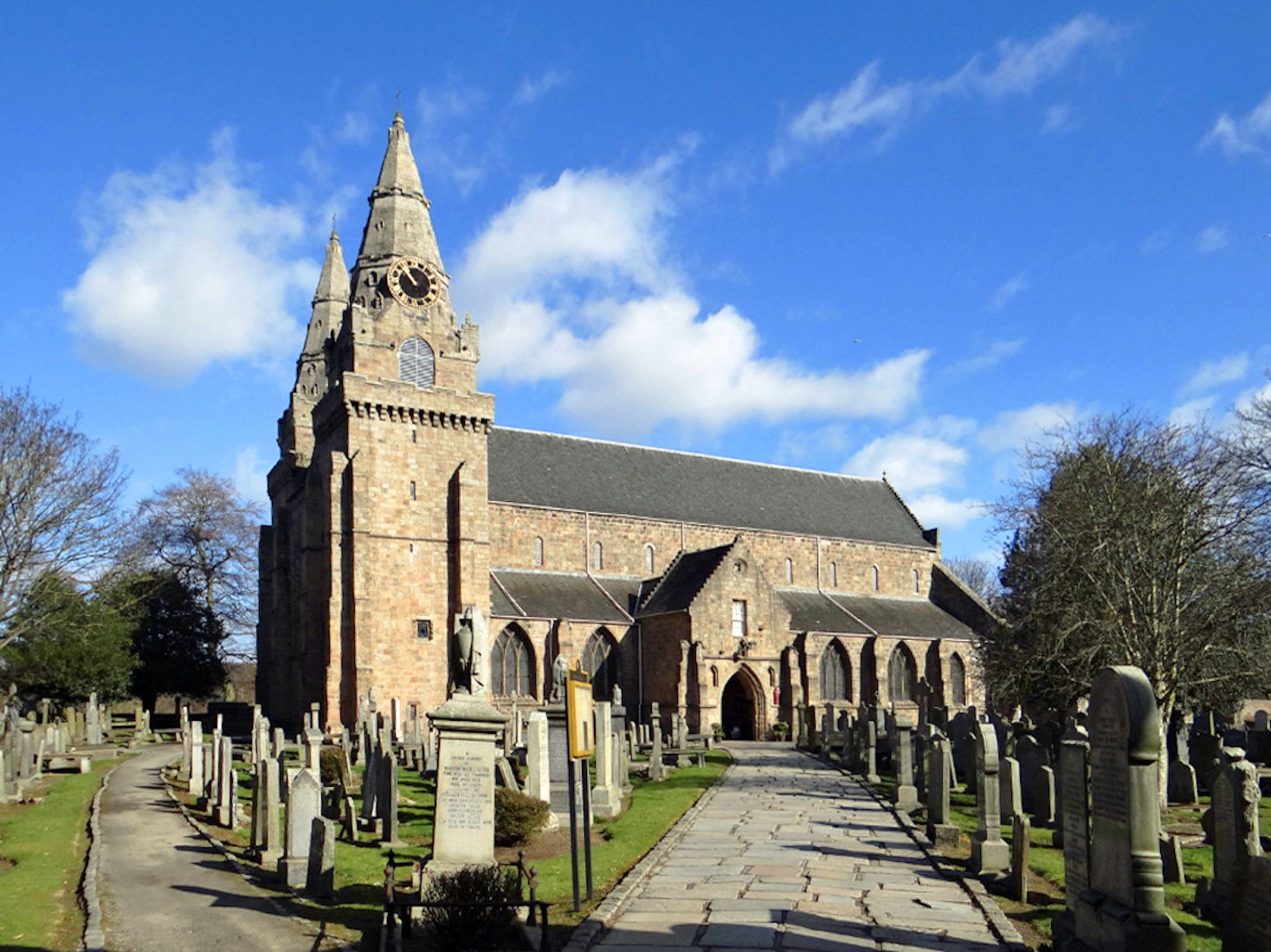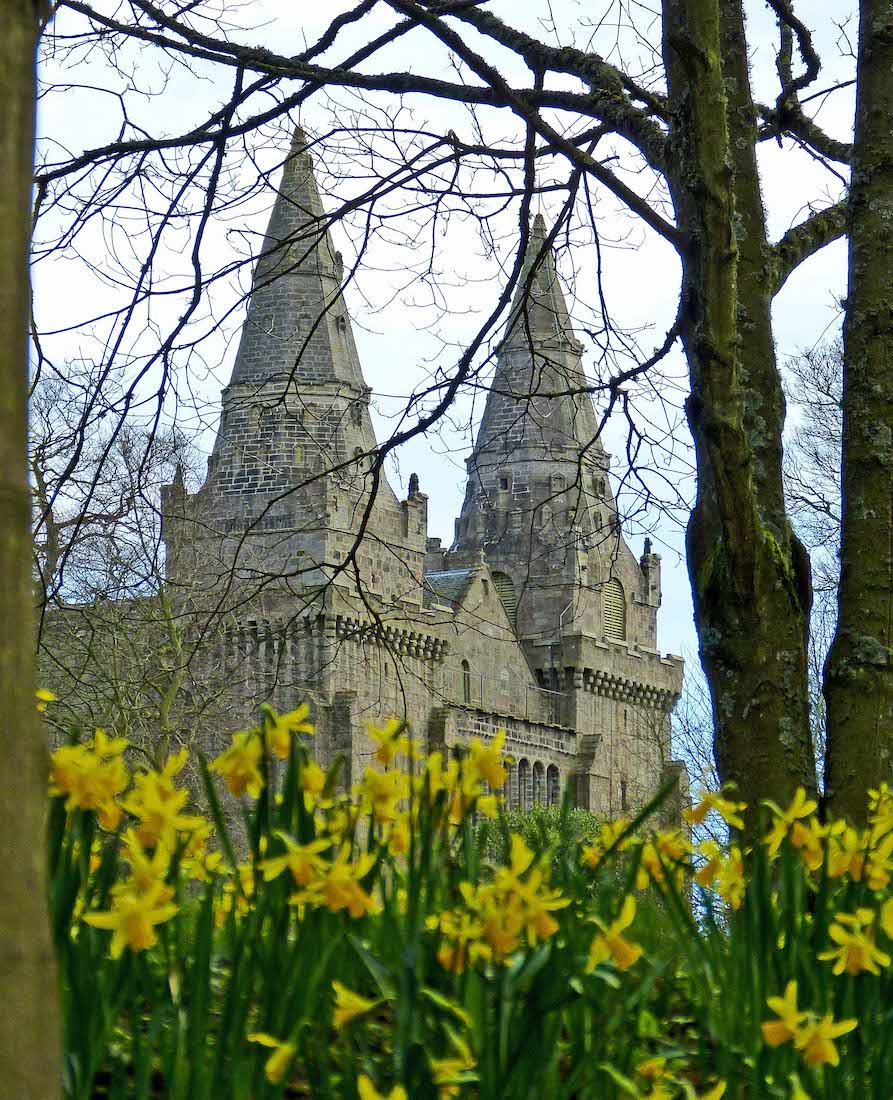
We begin our exploration of St Machar’s Cathedral at the Gatehouses. These are located a good couple of kilometres north of Aberdeen on an odd little complex of roads called The Chanonry. They were designed by John Smith in 1832 encasing previous structures of similar plan from the 18th century. Generally, a gatehouse is a strong fortified building designed to protect the entrance to a castle (cathedral!). As here, they often flank a defensive gate. INDEX
2. GATEHOUSE ARCH CD CD


There is a good view of the Western towers of the Cathedral, seen through this gatehouse arch. A solid lamp gives illumination at night.
3. SOUTH DOOR APPROACH IJ
Lairds and labourers, ministers and millers lie side-by-side in the crowded churchyard surrounding St Machar’s Cathedral. It is full of history and was used as the burial ground for the Old Machar Poorhouse. Records go back at least as far as 1642.
Photo Credit: Flickr Ian Jackson]
4. SOUTHWEST VIEW CD
After passing under the Gatehouse Arch, the path divides, and we take the left fork to make our way around the Western towers.
5. ANOTHER VIEW CD
There are many scenic viewpoints from which to appreciate the Cathedral! St. Machar's Cathedral is one of only a handful of churches in Scotland containing a set of bells hung for change ringing. Its eight bells were cast between 1906 and 1911 by Mears & Stainbank for another church, St. Stephen’s, West Ealing, London. The church was declared unsafe in 1979, and the bells were removed for storage. They were acquired by the Cathedral and, after refurbishment by Eayre & Smith, were installed in the South tower in 1987. Since that time, sixty-eight peals have been rung on the bells by members of the Ancient Society of College Youths and the Scottish Association of Change Ringers. The one hundredth peal on the bells was rung by members of the Scottish Association in September of 2000 to commemorate the rededication of the Cathedral’s sanctuary cross
6. LOOKING BACK TO THE GATEHOUSES CD
Here is a view looking back to the Gate Houses. It seems likely that there was once a high stone wall built right around the Cathedral. We shall find some sections of such walling.
7. WEST ENTRY CD
To the West there is another entry into the Churchyard. We can see the gateway just beyond the bicycles. This open area also provides a way of access to the beautiful adjoining Seaton Park which is overlooked by the Cathedral. Some more fortified walling can be seen here.
8. NORTHWEST VIEWS CD CD
Spring is obviously a good season in which to visit St Machar’s with hosts of golden daffodils! It is also worth walking back along the narrow Tillydrone Road for an interesting view back to the West wall of the Cathedral.
9. CATHEDRAL WALK IH
Trying to walk around the Cathedral we keep getting distracted! Just down in Seaton Park is the beautiful Cathedral Walk: two parallel paved paths leading to St Machar’s, separated by a grassy strip with large round flower beds – masses of colour in season.
10. WEST WALL AND DOOR W W
We return to the Cathedral. The tiny house between the gates is the watch house. This small building was used in the 1800s to watch out for body snatchers seeking corpses for the University anatomists! •• The studded red doors are the West doors of the Cathedral – perhaps seldom used these days? Photo Credits: Wikimedia Photo 1 Martyn Gorman; Photo 2 Stephencdickson]
11. NORTH WALL V
We walk along the North side of the Cathedral. There are graves along here. To our left is the wall separating the Cathedral from Seaton Park. We notice the buttresses and parapets along the Cathedral wall.
12. NORTH SIDE AND TOWER CD IH
Looking back in a more pleasant season! ••• The spire is interesting with its various little niches and protrusions. Some study required here!
13. GRAVES CD
Old graves are very interesting from an historic point of view, but can rapidly become untidy and fall into disrepair.
14. SOME SPECIAL GRAVES CD CD IH
Here are three snippets about the St Machar graves. •• Graves with bluebells – how lovely! •• Pixie: who was she? Obviously an angel, but there must be some story here. •• Gavin Dunbar (c. 1490–1547) became bishop of Aberdeen in 1519, and set about major rebuilding and extension of St Machar's Cathedral. Later he became archbishop of Glasgow.
15. EAST VIEW CD
We continue around to the East end of the Cathedral. We see that the large arch at theEast end of the nave has been filled in, and three long narrow windows installed. The Cathedral used to extend out in this direction. We shall find clear evidence of the transepts, but less of the original sanctuary.
16. EXTERIOR EAST WALL AND GABLE IH CD
These are closer views of the East wall. There is a strange green door leading nowhere in the gable, and lower down the stone East wall of the old transept is visible.
17. THROUGH THE ARCH V SMC
A circular archway leads through into the old transept where there are now various graves and plaques.
18. EAST WALL GROTESQUE IH IH
On either side of the main East window is a smaller window. The window on the South side is adorned with a couple of grotesques. One of these has a discernible face, the other is almost completely weathered away.
19. WALL POSTER V
Near the arch is an information poster about the transepts – unfortunately the quality of the photograph is poor. The text begins: ‘Bishop Henry Leighton [Henry de Lichton] (1422 – 42) ordered the building of the north transept, also known as St John’s Aisle. His effigy once lay inside the transept on an altar tomb beneath a canopy. Nothing of the tomb survives, but the effigy is kept inside the Cathedral. Bishop Leighton also completed the nave and the western towers.’
20. SOUTHEAST ENCLOSURE CD
Some of the graves in the churchyard have special enclosing walls.



























